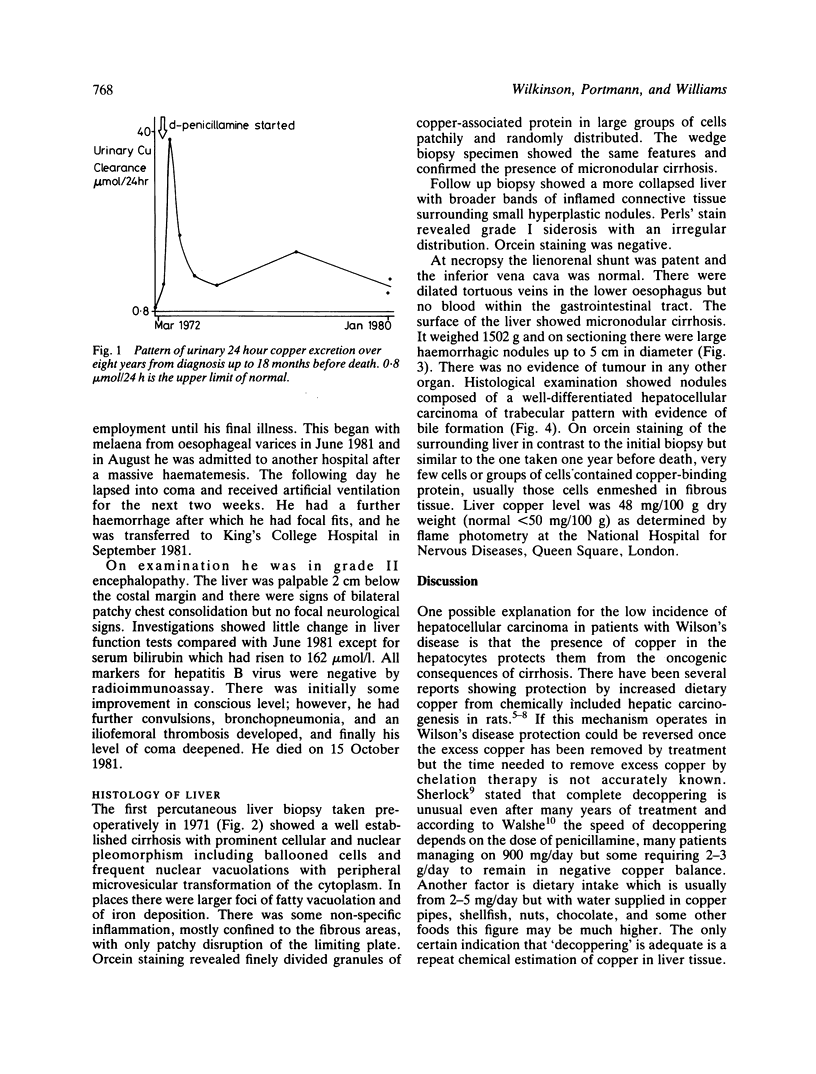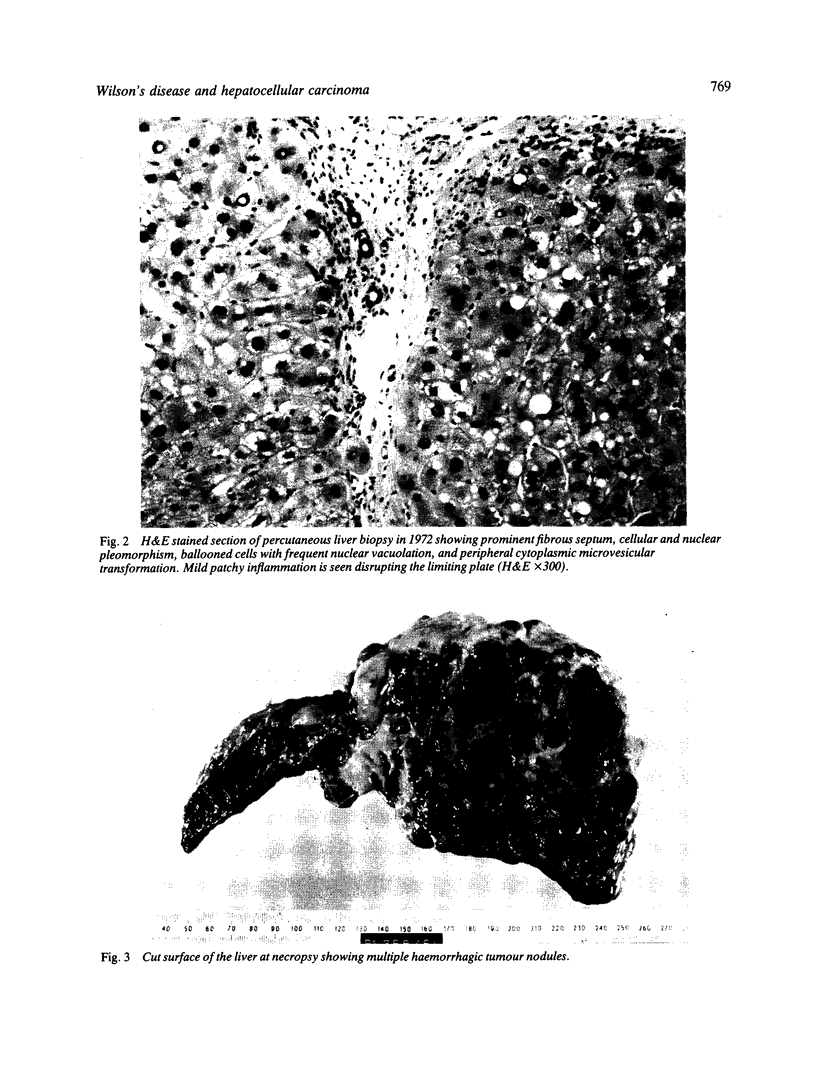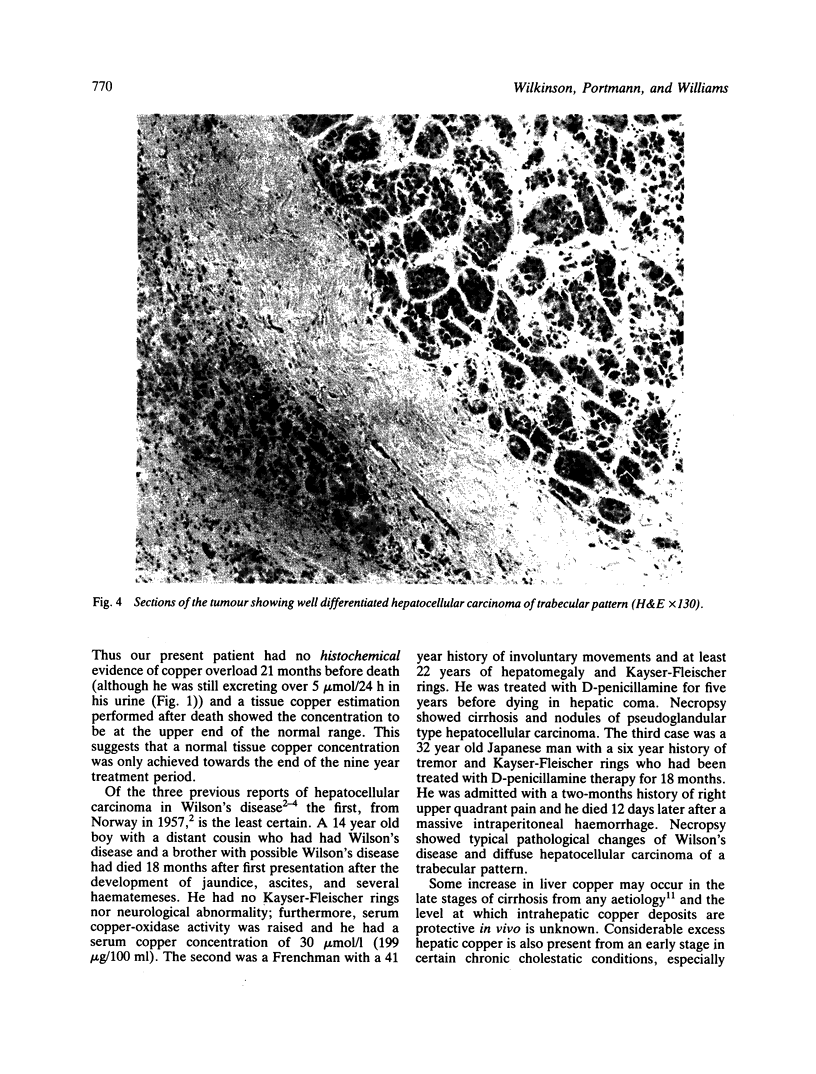Abstract
A male patient with Wilson's disease developed a hepatocellular carcinoma after treatment for nine years with D-penicillamine. Examination at necropsy showed that excess liver copper had been effectively removed. As copper has been shown to protect against chemically induced hepatocellular carcinoma in rats, this may be the reason for the extreme rarity of hepatocellular carcinoma in patients with Wilson's disease and possibly in other liver diseases with hepatic copper overload.
Full text
PDF




Images in this article
Selected References
These references are in PubMed. This may not be the complete list of references from this article.
- Berresford P. A., Sunter J. P., Harrison V., Lesna M. Histological demonstration and frequency of intrahepatocytic copper in patients suffering from alcoholic liver disease. Histopathology. 1980 Nov;4(6):637–643. doi: 10.1111/j.1365-2559.1980.tb02959.x. [DOI] [PubMed] [Google Scholar]
- Chapman R. W., Arborgh B. A., Rhodes J. M., Summerfield J. A., Dick R., Scheuer P. J., Sherlock S. Primary sclerosing cholangitis: a review of its clinical features, cholangiography, and hepatic histology. Gut. 1980 Oct;21(10):870–877. doi: 10.1136/gut.21.10.870. [DOI] [PMC free article] [PubMed] [Google Scholar]
- HOWELL J. S. The effect of copper acetate on p-dimethylaminoazobenzene carcinogenesis in the rat. Br J Cancer. 1958 Dec;12(4):594–608. doi: 10.1038/bjc.1958.67. [DOI] [PMC free article] [PubMed] [Google Scholar]
- Johnson P. J., Krasner N., Portmann B., Eddleston A. L., Williams R. Hepatocellular carcinoma in Great Britain: influence of age, sex, HBsAg status, and aetiology of underlying cirrhosis. Gut. 1978 Nov;19(11):1022–1026. doi: 10.1136/gut.19.11.1022. [DOI] [PMC free article] [PubMed] [Google Scholar]
- KING H. J., SPAIN J. D., CLAYTON C. C. Dietary copper salts and azo dye carcinogenesis. J Nutr. 1957 Oct 10;63(2):301–309. doi: 10.1093/jn/63.2.301. [DOI] [PubMed] [Google Scholar]
- Kamakura K., Kimura S., Igarashi S., Fujiwara K., Toshitsugu O. [A case of Wilson's disease with hepatoma (author's transl)]. Nihon Naika Gakkai Zasshi. 1975 Mar 10;64(3):232–238. doi: 10.2169/naika.64.232. [DOI] [PubMed] [Google Scholar]
- Kamamoto Y., Makiura S., Sugihara S., Hiasa Y., Arai M. The inhibitory effect of copper on DL-ethionine carcinogenesis in rats. Cancer Res. 1973 May;33(5):1129–1135. [PubMed] [Google Scholar]
- Krasner N., Johnson P. J., Portmann B., Watkinson G., Macsween R. N., Williams R. Hepatocellular carcinoma in primary biliary cirrhosis: report of four cases. Gut. 1979 Mar;20(3):255–258. doi: 10.1136/gut.20.3.255. [DOI] [PMC free article] [PubMed] [Google Scholar]
- LYGREN T. Hepatolenticular degeneration (Wilson's disease) and juvenile cirrhosis in the same family. Lancet. 1959 Feb 7;1(7067):275–276. doi: 10.1016/s0140-6736(59)90202-8. [DOI] [PubMed] [Google Scholar]
- PEDRERO E., Jr, KOZELKA F. L. Effect of copper on hepatic tumors produced by 3-methyl-4-dimethylaminoazobenzene. AMA Arch Pathol. 1951 Nov;52(5):455–457. [PubMed] [Google Scholar]
- Walshe J. M. The physiology of copper in man and its relation to Wilson's disease. Brain. 1967 Mar;90(1):149–176. doi: 10.1093/brain/90.1.149. [DOI] [PubMed] [Google Scholar]
- Wiesner R. H., LaRusso N. F. Clinicopathologic features of the syndrome of primary sclerosing cholangitis. Gastroenterology. 1980 Aug;79(2):200–206. [PubMed] [Google Scholar]





